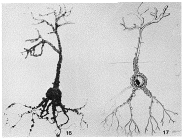RAS taxon details
Notodendrodes DeLaca, Lipps & Hessler, 1980
395127 (urn:lsid:marinespecies.org:taxname:395127)
accepted
Genus
Notodendrodes antarctikos DeLaca, Lipps & Hessler, 1980 (type by original designation)
marine, brackish, fresh, terrestrial
masculine
DeLaca, T. E.; Lipps, J. H.; R.Hessler, R. (1980). The morphology and ecology of a new large agglutinated Antarctic foraminifer (Textulariina: Notodendrodidae nov.). <em>Zoological Journal of the Linnean Society.</em> 69(3): 205-224., available online at https://doi.org/10.1111/j.1096-3642.1980.tb01123.x
page(s): p. 210 [details] Available for editors
page(s): p. 210 [details] Available for editors
Hayward, B.W.; Le Coze, F.; Vachard, D.; Gross, O. (2025). World Foraminifera Database. Notodendrodes DeLaca, Lipps & Hessler, 1980. Accessed through: RAS (Eds.) (2025) Register of Antarctic Species at: https://ras.biodiversity.aq/aphia.php/www.pfeil-verlag.de/04biol/rest/aphia.php?p=taxdetails&id=395127 on 2025-09-12
RAS (Eds.) (2025). Register of Antarctic Species. Notodendrodes DeLaca, Lipps & Hessler, 1980. Accessed at: https://ras.biodiversity.aq/aphia.php?p=taxdetails&id=395127 on 2025-09-12
Date
action
by
original description
DeLaca, T. E.; Lipps, J. H.; R.Hessler, R. (1980). The morphology and ecology of a new large agglutinated Antarctic foraminifer (Textulariina: Notodendrodidae nov.). <em>Zoological Journal of the Linnean Society.</em> 69(3): 205-224., available online at https://doi.org/10.1111/j.1096-3642.1980.tb01123.x
page(s): p. 210 [details] Available for editors
additional source Loeblich, A. R.; Tappan, H. (1987). Foraminiferal Genera and their Classification. Van Nostrand Reinhold Company, New York. 970pp., available online at https://books.google.pt/books?id=n_BqCQAAQBAJ [details] Available for editors
page(s): p. 210 [details] Available for editors
additional source Loeblich, A. R.; Tappan, H. (1987). Foraminiferal Genera and their Classification. Van Nostrand Reinhold Company, New York. 970pp., available online at https://books.google.pt/books?id=n_BqCQAAQBAJ [details] Available for editors
 Present
Present  Inaccurate
Inaccurate  Introduced: alien
Introduced: alien  Containing type locality
Containing type locality

